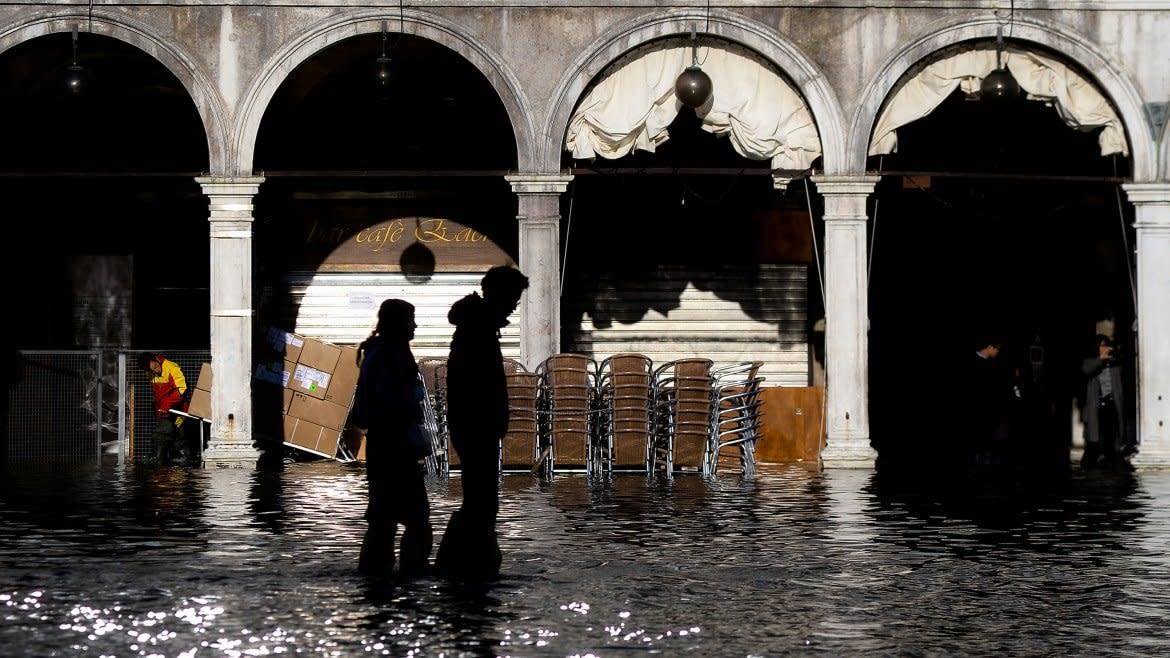Venice Isn’t Italy’s Only Weather Disaster. Rome and Florence Are Also Under Threat

ROME–It has been one week since historic floods caused more than a billion dollars worth of damage in Venice, and the skies are not exactly clearing. All across the country, extreme weather has flooded rivers, downed trees, caused mudslides, and wreaked collective havoc. And according to a new report called “The Climate Has Already Changed” released Tuesday by Italy’s environmental watchdog group Legambiente, this is just the beginning.
The report paints a grim picture of how climate change is impacting the Italian peninsula, which is geographically doomed thanks to rising seas on three sides. The authors list 40 coastal cities at risk, including Venice, Trieste, Ravenna, Pescara, La Spezia, Cagliari, Oristano, and Trapani, that could face widespread evacuations of its citizens by 2050.
But the report also says that recent and predicted weather between now and the end of the year is likely to have major economic and logistic impact on Rome, Milan, Genoa, Naples, Palermo, Catania, Bari, Reggio Calabria, and Turin.
If the last week is any sign, there isn’t much room for optimism. Among the many weather related disasters in the last seven days are multiple mudslides in the north of the country, including one that caused the derailment of a train. No one was injured, but the mud also caused the closure of several highways, isolating the Pusteria Valley near the Austrian border and temporarily closing the Brenner Pass.
In Tuscany, the swollen Arno river reached its highest level in 27 years, causing a dike to break and flooding low lying areas which led to the evacuation of several hundred people. In the tourist haven of Florence, city authorities are on alert until at least Friday as the river inches towards the city’s flood walls and nearly touched the bottom of the city’s most famous bridge Ponte Vecchio.
Outside Florence, the popular Saturnia natural springs have been closed due to raging rivers that have forever altered the path of the spring waters. “There has sadly been huge damage in the area of the Molino Falls, also known as the cascatelle of Gorello at Saturnia,” Mirco Morini, mayor of Manciano near Grosseto told ANSA on Tuesday. “The falls have been temporarily closed for safety reasons. Above and below the falls, the Stellata River has changed its course with force and for that reason it will need a restyling.”
A rare tornado also struck the area on Monday, destroying 1,000 pine trees in the Feniglia nature reserve in southern Tuscany.
In nearby Pisa, 170 paratroopers were deployed to try to bolster the city’s flood defences after the Arno river rose dramatically. They had to be airlifted in due to closed roads.
In central Italy, more than 10,000 people were still without electricity Wednesday morning after storms wiped out power lines. An elderly couple had to be airlifted to safety after the Idice river flooded the city of Bologna.
In Rome, which suffered from the highest number of weather-related disasters in 2018, trees fell like matchsticks, gravely injuring one person Sunday night when a giant umbrella pine crashed onto his car.
Local officials called a state of emergency in Matera in the southern region of Basilicata, after flood waters ripped through the mountain town, at least $8 million worth of damage to infrastructure and private homes. The city was named 2019 European Culture Capital and gone through vital revitalization before the floods hit.
There isn’t much that can be done to curtail nature’s violent force, but Legambiente says that years of complacency has led to Italy’s current crisis situation. Budget cuts and several years of deadly earthquakes that soaked up funds have led to a total lack of preparedness when it comes to climate-related disasters. “We are the only large European country without a climate adaptation plan,” the Legambiente authors state, pointing out that Italy currently spends four times as much on damage repair as on preventive measures. Earlier this year, Italy did take one notable preventative measure—it closed down the Italian side of Mont Blanc due to the threat of the glacier breaking apart.
More than 75 percent of Italy is under red alert for continuing floods brought on by seemingly unending torrential rain storms until Friday. After that, the national weather service says the normal winter storm season will start.
Get our top stories in your inbox every day. Sign up now!
Daily Beast Membership: Beast Inside goes deeper on the stories that matter to you. Learn more.

